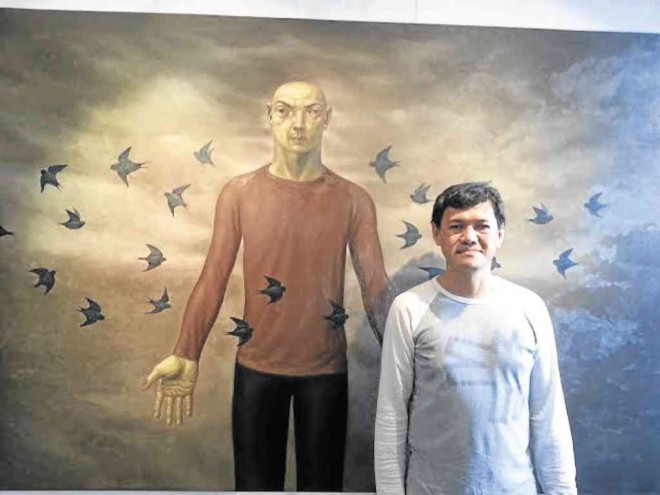
Amid lush greenery and blooms, Pintô Art Museum on Sierra Madre Street, Grand Heights, Antipolo City, is a treasure trove of the visual arts.
It is owned and managed by neurologist Joven Cuanang, retired medical director of St. Luke’s Medical Center, former dean of the University of the East College of Medicine, and art patron and collector.
His 1980s encounter with a group of young artists who did not have a gallery to exhibit their works made him convert the garden of his Antipolo residence into a gallery.
The artists hung their early works like laundry on a sampayan (clothesline) in the gallery, Cuanang said.
The young artists later did large-scale canvases in Social-Realist mode and came to be known as Salingpusa. Their impressive works are all over the doctor’s museum.
Notable is the 144” x 480” acrylic on canvas titled “Karnabal,” a 1992 collaborative work of Rolly Acuña, Elmer Borlongan, Karen Flores, Emmanuel Garibay, Mark Justiniani, Antonio C. Leaño, Erwin C. Leaño, Joy Mallari, Neil A. Manalo, Andy Orencio, Jim Orencio, Vincent Paul Padilla, Anthony Palomo, Mikel Parial, José Santos III and Geronimo Tapales, names that are now familiar to art-lovers.
Figurative expressionist
In the mid-’90s, the Salingpusa artists launched their individual careers. One who particularly stood out was Borlongan.
A recipient of the Cultural Center of the Philippines’ Thirteen Artist Award in 1994, Borlongan is best known for his Figurative Expressionism, the idiom of his favorite artists Onib Olmedo, Danny Dalena and Jaime de Guzman.
Of Olmedo, he said: “I have witnessed Onib draw and paint with other artists. I admire his spontaneity and closeness to his subject matter. I love the freedom in his brushstrokes, without hewing to the correct proportion of human anatomy but capturing the soul of every figure.”
Borlongan’s iconic depiction of ordinary people at work, at play or even at rest is a wonder of transformation into a tableau of quiet humor and irony. His works are character studies, almost always represented by a lone, gaunt, distorted figure against a simple monochromatic background. The paintings have become one of the most sought-after in Southeast Asian auctions.
Son of a chemist father and pharmacist mother who are always supportive of his art, Borlongan says that at age 11 he studied drawing and painting under Fernando Sena. He intimated that he copied the style of his teachers and idols in Philippine art, including his favorite, Botong Francisco.
He took up Fine Arts, major in Painting, at University of the Philippines Diliman.
In 1993, he held his first solo exhibit, “Aki,” at the Boston Gallery. He considers it his most significant show, as it defined his identity as an artist.
Significant, too, was the 12’ x 12’ mural “Huntahan,” showing three men in a huddle, which he painted for the boudoir of writer and artist Gilda Cordero-Fernando.
Borlongan was referred to Cordero-Fernando by another artist, Roberto Feleo, when she was looking for a muralist. That was in 1996, and Borlongan was 29 years old.
While he was doing it in his Mandaluyong studio, Gilda visited him and quipped upon seeing the big painting: “Sa kamay at paa pa lang, panalo na!”
Family paintings
Borlongan recently opened his solo exhibit at Pintô, “Labyrinth of Kinship.” On exhibit are works in oil, acrylic, watercolor, charcoal and pen-and-ink.
The title is taken from Gabriel Garcia Marquez’s “One Hundred Years of Solitude,” and the exhibit shows a maze of life’s realities.
Borlongan emphasizes that his new works are more personal, revolving around his immediate family.
“Sitting Pretty” depicts his wife, Plet Bolipata. He feels lucky to have an artist for his wife. They encourage each other’s artistic pursuit by not commenting on each other’s work until it is through.
Constantly experimenting, Borlongan is inspired by the works of Mexican muralists as well as European and Filipino expressionists. He hopes to launch a retrospective of his 25 years in the arts by 2017.
His exhibit at Pintô Art Museum also features a fashion program, “Wear Abel,” in cooperation with Gameng Foundation of Ilocos Norte, side by side with the newly opened Museum of Indigenous Art.
The author is the executive director of the Maningning Miclat Art Foundation Inc. Deadline for submission to its 2015 Poetry Competition in English, Filipino and Chinese is on April 15. Log on to www.maningning.com or www.facebook.com/pages/Maningning-Miclat/47647085844?ref=hl.